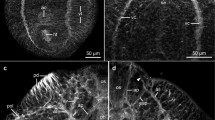Abstract
The nervous systems of the turbellarians Microstomum lineare and Polycelis nigra and of the cestodes Diphyllobothrium dendriticum and Schistocephalus solidus were studied by means of the peroxidase-antiperoxidase (PAP) immunocytochemical method, with the use of antisera to the neuropeptides FMRF-amide, vasotocin, leu-enkephalin, met-enkephalin, neurotensin, somatostatin, and VIP, and to the bioamine serotonin. Anti-FMRF-amide positive perikarya and fibers occurred in all species, while the occurrence of the vertebrate brain-gut peptides and serotonin varied between the species. Anti-somatostatin and anti-VIP gave a negative result. Anti-FMRF-amide and anti-vasotocin positive immunoreactivity was found in the brain and gut of M. lineare, and in the CNS and the peripheral nerve net of the cestodes. We suggest that the brain-gut peptides of free-living flatworms act on the subtegumental region in the cestodes, which lack a gut but absorb their nutrients directly through the tegument.
Similar content being viewed by others
References
Bautz, A., J. Schilt, J. P. Richoux & M. P. Dubois, 1980. Détection immunocytologique, dénombrement et localisation des cellules à somatostatine (SRIF) chez deux espèces de Planaires, Dugesia lugubris et Dendrocoelum lacteum (Turbellariès, Triclades). C.r. Acad. Sci., Paris. Ser. D. 291: 833–836.
Carraway, R., S. E. Ruane & H.-R. Kim, 1982. Distribution and immunochemical character of neurotensin-like material in representative vertebrates and invertebrates: apparent conservation of the COOH-terminal region during evolution. Peptides 1: 115–123.
Cottrell, G. A., L. P. Schot & G. J. Dockray, 1983. Identification and probable role of a single neurone containing the neuropeptide Helix FMRF-amide. Nature 304: 638–640.
Dockray, G. J., C. Vaillant, R. G. Williams, R. J. Gayton & N. N. Osborne, 1981. Vertebrate brain-gut peptides related to FMRF-amide and Met-enkephalin Arg6Phe7. Peptides 2: 25–30.
Greenberg, M. J. & D. A. Price, 1980. Cardioregulatory peptides in molluscs. In F. E. Bloom (ed.), Peptides: Integrators of Cell and Tissue Function. Raven Press, New York: 107–126.
Greenberg, M. J. & D. A. Price, 1983. Invertebrate neuropeptides: native and naturalized. Ann. Rev. Physiol. 45: 271–288.
Grimmelikhuijzen, C. J. P., 1983. FMRF-amide immunoreactivity is generally occurring in the nervous system of coelenterates. Histochemistry 78: 361–381.
Grimmelikhuijzen, C. J. P., R. E. Carraway, Å. Rökaeus & F. Sundler, 1981. Neurotensin-like immunoreactivity in the nervous system of hydra. Histochemistry 72: 199–209.
Gustafsson, M. K. S. & M. C. Wikgren, 1981a. Peptidergic and aminergic neurons in adult Diphyllobothrium dendriticum Nitzsch, 1824 (Cestoda, Pseudophyllidea). Z. Parasitenkd 64: 121–134.
Gustafsson, M. K. S. & M. C. Wikgren, 1981b. Activation of the peptidergic neurosecretory system in Diphyllobothrium dendriticum (Cestoda, Pseudophyllidea). Parasitology 83: 243–247.
Gustafsson, M. K. S. & M. C. Wikgren, 1981c. Release of neurosecretory material by protrusions of bounding membranes extending through the axolemma, in Diphyllobothrium dendriticum (Cestoda). Cell Tissue Res. 220: 473–479.
Juel, C., 1982. Enkephalin increases the efficacy of dopaminergic transmission in Helix pomatia. Neurophysiology 21: 1301–1303.
Krieger, D. T., 1983. Brain peptides: what, where, and why? Science 222: 975–985.
Lur'e, B. L., 1975. Monoamine-containing neurons of the planarian Polycelis nigra (Turb.). Moscow Univ. Biol. Sci. Bull. 30: 69–76.
Polak, J. M. & S. R. Bloom, 1982. Localization of regulatory peptides in the gut. Br. med. Bull. 38: 303–307.
Price, D. A. & M. J. Greenberg, 1977. Structure of a molluscan cardioexcitatory neuropeptide. Science 197: 670–671.
Reuter, M., 1981. The nervous system of Microstomum lineare (Turbellaria, Macrostomida). II. The ultrastructure of synapses and neurosecretory release sites. Cell Tissue Res. 218: 375–387.
Reuter, M., T. Karhi & L. P. C. Schot, 1984. Immunocytochemical demonstration of peptidergic neurons in the central and peripheral nervous system of the flatworm Microstomum lineare with antiserum to FMRF-amide. Cell Tissue Res. 238: 431–436.
Reuter, M. & I. Palmberg, 1983. Asexual reproduction in Microstomum lineare (Turbellaria). II. The nervous system in the division zone. Int. J. Invert. Reprod. 6: 207–217.
Reuter, M., M. Wikgren & I. Palmberg, 1980. The nervous system of Microstomum lineare (Turbellaria, Macrostomida). I. A fluorescence and electron microscopic study. Cell Tissue Res. 211: 31–40.
Schilt, J., J. P. Richoux & M. P. Dubois, 1981. Demonstration of peptides immunologically related to vertebrate neurohormones in Dugesia lugubris (Turbellaria, Tricladida). Gen. Comp. Endocrinol. 43: 331–335.
Schot, L. P. C. & H. H. Boer, 1982. Immunocytochemical demonstration of peptidergic cells in the pond snail Lymnaea stagnalis with an antiserum to the molluscan cardioactive tetrapeptide FMRF-amide. Cell Tissue Res. 225: 347–354.
Schot, L. P. C., H. H. Boer & J. Vijdenes, 1983. Localization of neurons innervating the heart of Lymnaea stagnalis studied immunocytochemically with anti-FMRF-amide and antivasotocin. In J. Lever & H. H. Boer (eds), Molluscan Neuroendocrinology. Mon. Royal Neth. Academy of Arts and Sciences, North Holland Publ. Comp., Amsterdam, Oxford, New York: 203–208.
Stefano, G. B., E. J. Catapane & R. M. Kream, 1981. Characterization of the dopamine stimulated adenylate cyclase in the pedal ganglia of Mytilus edulis: Interactions with etorphine, β-endorphin, DALA, and methionine enkephalin. Cell Mol. Neurobiol. 1: 57–68.
Sternberger, L. A., P. H. Hardy Jr., J. J. Cuculis & H. G. Meyer, 1970. The unlabelled antibody enzyme method of immunochemistry. Preparations and properties of soluble antigen-antibody complex (Horseradish peroxidase-antihorseradish peroxidase) and its use in identification of spirochetes. J. Histochem. Cytochem. 18: 315–333.
Venturini, G., A. Carolei, G. Palladini, V. Margotta & M. G. Lauro, 1983. Radioimmunological and immunocytochemical demonstration of met-enkephalin in planaria. Comp. Biochem. Physiol. C. 74: 23–25.
Author information
Authors and Affiliations
Rights and permissions
About this article
Cite this article
Wikgren, M., Reuter, M. & Gustafsson, M. Neuropeptides in free-living and parasitic flatworms (Platyhelminthes). An immunocytochemical study. Hydrobiologia 132, 93–99 (1986). https://doi.org/10.1007/BF00046234
Issue Date:
DOI: https://doi.org/10.1007/BF00046234



